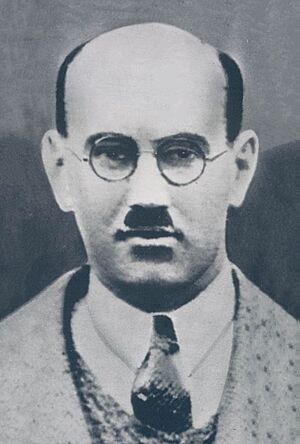Alan Nunn May facts for kids
Quick facts for kids
Alan Nunn May
|
|
|---|---|
 |
|
| Born | 2 May 1911 Bedruthan, Park Hill, Moseley, Birmingham, England
|
| Died | 12 January 2003 (aged 91) Cambridge, Cambridgeshire, England
|
| Education | Trinity Hall, Cambridge, King's College London |
| Political party | Communist Party of Great Britain (CPGB) |
| Criminal charge(s) | Espionage |
| Criminal penalty | 10 years of hard labour (served 6 years) |
| Spouse(s) | Hilde Broda |
| Children | 1 son |
Alan Nunn May (sometimes Allan) (2 May 1911 – 12 January 2003) was a British scientist who studied physics. During World War II, he secretly shared important information about British and American atomic research with the Soviet Union. He was later found guilty of spying.
Contents
Early Life and Education
Alan Nunn May was born in Birmingham, England. He was the youngest of four children. He went to King Edward's School in Birmingham.
He earned a scholarship to Trinity Hall, Cambridge, where he studied physics and did very well. After that, he continued his studies and later became a lecturer at King's College London.
His Career and Secret Work
Early Connections
In the 1930s, May joined the Communist Party of Great Britain. He was also active in a group called the Association of Scientific Workers. Another famous spy, Donald Duart Maclean, was also at Trinity Hall around the same time.
World War II Work
During World War II, May first worked on radar technology. Later, he joined a team at Cambridge University that was looking into a possible heavy water nuclear reactor. This team was part of a British project called Tube Alloys.
The British project later joined forces with the American Manhattan Project. This was a huge effort to create a nuclear weapon. In 1943, May's team moved to the Montreal Laboratory in Canada. They were building a reactor there. May's work in Canada finished in September 1945, and he went back to his teaching job in London.
Spying for the Soviet Union
Even though he had stopped being an official member of the Communist Party by 1940, May began sharing secrets. While at Cambridge, he saw a report that mentioned Germany might be able to build a "dirty bomb." He passed this information to a Soviet contact.
In Canada, a Soviet military intelligence officer named Lieutenant Angelov asked May for information about atomic research. May continued to spy by secretly giving small samples of special atoms called uranium-233 and uranium-235. The person who carried these samples was not told about the danger of radiation. This person later developed serious health problems.
May also borrowed important research documents from libraries, many from the US, so they could be copied. A Canadian investigation later found that he was paid with two bottles of whiskey and at least C$700. May said he took the money but then burned it. Angelov gave him instructions for a secret meeting in London after May returned home.
Caught and Convicted
In September 1945, a Soviet cipher clerk named Igor Gouzenko left the Soviet Union and shared secret documents with Western countries. These documents showed that May was involved in spying. They even included details about the planned meeting in London.
May did not go to the meeting. He was arrested in March 1946 and admitted to spying. On May 1, 1946, he was sentenced to ten years in prison. He was released in late 1952, after serving about six and a half years.
After his release, May said he believed he had "acted rightly" as a spy. He claimed he was focused on helping defeat Nazi Germany and Japan, and on developing peaceful uses for atomic energy.
Because he was blacklisted from universities in Britain, May worked for a company that made scientific instruments. In 1961, he moved to the University of Ghana. There, he did research and even created a science museum.
Personal Life and Death
In 1953, May married Hilde Broda. They had one son together. Hilde also had a son from a previous marriage.
May returned to Cambridge in 1978. He passed away in a hospital there on January 12, 2003, from pneumonia and lung disease.
After his death, a statement he had dictated in 2002 was released. In it, he confessed to his spying activities. He explained that he felt the Soviets "ought to be informed" about the atomic secrets.
Legacy
Alan Nunn May's arrest and conviction in 1946 were the first public proof that the Soviet Union had obtained atomic secrets through spying. His case also made the United States distrust Britain, leading to the McMahon Act. May shared information about atomic reactors. However, unlike another spy named Klaus Fuchs, May knew little about how atomic weapons were designed.
May is an important character in the 2003 book The Cloud Chamber by Clare George. This novel tells a fictional story about physicists in Cambridge in the 1930s. It explores the excitement of scientific discoveries and the difficult moral choices scientists faced during World War II.
See also
- Atomic spies
- Cold War espionage
- Nuclear espionage
- Soviet atomic bomb project
- Soviet espionage in the United States

